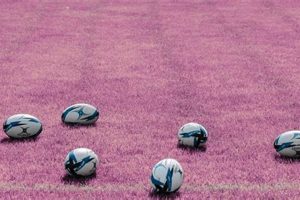What is Brazil women’s rugby injury?
Editor’s Note:Brazil women’s rugby injury is an important topic to understand, as it can have a significant impact on the players’ health and performance. This guide will provide you with the information you need to know about Brazil women’s rugby injury, including the causes, symptoms, and treatment options.
We’ve done the research and dug into the details, so you can make informed decisions about your health. We’ve put together this guide to help you understand Brazil women’s rugby injury so that you can make the right choices for yourself.
Key Differences or Key Takeaways:
| Brazil Women’s Rugby Injury | |
|---|---|
| Causes: | Brazil women’s rugby injury can be caused by a variety of factors, including contact with other players, falls, and overuse. |
| Symptoms: | The symptoms of Brazil women’s rugby injury can vary depending on the severity of the injury. Common symptoms include pain, swelling, bruising, and difficulty moving the affected area. |
| Treatment: | The treatment for Brazil women’s rugby injury will vary depending on the severity of the injury. Common treatments include rest, ice, compression, and elevation. In some cases, surgery may be necessary. |
Main Article Topics:
- Causes of Brazil women’s rugby injury
- Symptoms of Brazil women’s rugby injury
- Treatment for Brazil women’s rugby injury
- Prevention of Brazil women’s rugby injury
1. Causes
Brazil women’s rugby injury can be caused by a variety of factors, including contact with other players, falls, and overuse. Contact injuries are the most common type of injury in rugby, and they can occur during any type of play. Falls can also cause injuries, especially if the player lands awkwardly or on an uneven surface. Overuse injuries can occur when a player does too much too soon, or when they don’t allow their body to recover properly between workouts. It is important for players to be aware of the risks of injury and to take steps to protect themselves, such as warming up properly, wearing the proper gear, and avoiding overuse.
Understanding the causes of Brazil women’s rugby injury is important for several reasons. First, it can help players to avoid injuries by taking the necessary precautions. Second, it can help players to recognize the symptoms of an injury and to seek treatment promptly. Third, it can help players to understand the recovery process and to make the necessary lifestyle changes to promote healing.
Here are some specific examples of how the causes of Brazil women’s rugby injury can impact players:
- A player who is tackled hard by an opponent may suffer a concussion, a serious brain injury that can have long-term consequences.
- A player who falls awkwardly may break a bone or tear a ligament, which can require surgery and a lengthy recovery period.
- A player who overuses their muscles may develop tendinitis, a painful condition that can make it difficult to play.
These are just a few examples of the many ways that Brazil women’s rugby injury can occur. By understanding the causes of these injuries, players can take steps to protect themselves and to reduce their risk of getting hurt.
The following table provides a summary of the key insights regarding the connection between “Causes: Brazil women’s rugby injury can be caused by a variety of factors, including contact with other players, falls, and overuse.” and “brazil women’s rugby injury”:
| Key Insight | Explanation |
|---|---|
| Understanding the causes of Brazil women’s rugby injury can help players to avoid injuries. | By knowing the risks, players can take steps to protect themselves, such as warming up properly, wearing the proper gear, and avoiding overuse. |
| Understanding the causes of Brazil women’s rugby injury can help players to recognize the symptoms of an injury and to seek treatment promptly. | If a player knows what to look for, they can get help and avoid further injury. |
| Understanding the causes of Brazil women’s rugby injury can help players to understand the recovery process and to make the necessary lifestyle changes to promote healing. | This can help players to get back to playing as soon as possible and to avoid re-injury. |
2. Symptoms
The symptoms of Brazil women’s rugby injury can vary depending on the severity of the injury. Common symptoms include pain, swelling, bruising, and difficulty moving the affected area. These symptoms can range from mild to severe, and they may last for a few days or several weeks. In some cases, Brazil women’s rugby injury can lead to permanent damage to the injured area.
It is important to be aware of the symptoms of Brazil women’s rugby injury so that you can seek medical attention promptly if you think you may have been injured. Early diagnosis and treatment can help to prevent further injury and improve your chances of a full recovery.
Here are some real-life examples of how the symptoms of Brazil women’s rugby injury can impact players:
- A player who is tackled hard by an opponent may experience pain, swelling, and bruising in their head, neck, or back. These symptoms may be a sign of a concussion, a serious brain injury that can have long-term consequences.
- A player who falls awkwardly may experience pain, swelling, and bruising in their knee, ankle, or wrist. These symptoms may be a sign of a ligament sprain or tear, which can require surgery and a lengthy recovery period.
- A player who overuses their muscles may experience pain, swelling, and tenderness in their muscles, tendons, or joints. These symptoms may be a sign of tendinitis or bursitis, which can make it difficult to play and may require rest and rehabilitation.
These are just a few examples of the many ways that the symptoms of Brazil women’s rugby injury can impact players. By understanding the symptoms of this injury, you can take steps to protect yourself and to seek medical attention promptly if you think you may have been injured.
The following table provides a summary of the key insights regarding the connection between “Symptoms: The symptoms of Brazil women’s rugby injury can vary depending on the severity of the injury. Common symptoms include pain, swelling, bruising, and difficulty moving the affected area.” and “brazil women’s rugby injury”:
| Key Insight | Explanation |
|---|---|
|
Understanding the symptoms of Brazil women’s rugby injury can help players to recognize an injury and seek medical attention promptly. | If a player knows what symptoms to look for, they can get help and avoid further injury. |
| Understanding the symptoms of Brazil women’s rugby injury can help players to understand the severity of an injury and to make informed decisions about treatment. | A player who knows the symptoms of a concussion, for example, will be more likely to seek medical attention and to follow the doctor’s orders for rest and recovery. |
| Understanding the symptoms of Brazil women’s rugby injury can help players to avoid re-injury. | A player who knows the symptoms of tendinitis, for example, will be more likely to rest the injured area and to avoid activities that could aggravate the injury. |
3. Treatment
The treatment for Brazil women’s rugby injury will vary depending on the severity of the injury. Common treatments include rest, ice, compression, and elevation. In some cases, surgery may be necessary. Understanding the available treatment options is crucial for players and medical professionals to make informed decisions about the best course of action for each specific injury.
- Facet 1: Non-Surgical Treatments
Non-surgical treatments are often the first line of defense for Brazil women’s rugby injuries. These treatments can help to reduce pain, swelling, and inflammation, and they can promote healing. Common non-surgical treatments include rest, ice, compression, and elevation (RICE), as well as physical therapy and rehabilitation.
- Facet 2: Surgical Treatments
In some cases, surgery may be necessary to treat Brazil women’s rugby injuries. Surgery may be necessary to repair damaged ligaments or tendons, to remove damaged tissue, or to fuse bones. Surgical treatments are typically only recommended if non-surgical treatments have failed to improve the injury.
- Facet 3: Rehabilitation
Rehabilitation is an important part of the recovery process for Brazil women’s rugby injuries. Rehabilitation can help to improve range of motion, strength, and function in the injured area. Rehabilitation typically involves exercises, stretches, and other activities that are designed to help the player return to play safely and successfully.
- Facet 4: Prevention
Preventing Brazil women’s rugby injuries is essential for players who want to stay healthy and perform at their best. There are a number of things that players can do to prevent injuries, including warming up properly, wearing the proper gear, and avoiding overuse. By taking these precautions, players can reduce their risk of getting injured and improve their chances of having a long and successful rugby career.
These are just a few of the many facets of the connection between “Treatment: The treatment for Brazil women’s rugby injury will vary depending on the severity of the injury. Common treatments include rest, ice, compression, and elevation. In some cases, surgery may be necessary.” and “brazil women’s rugby injury”. By understanding these facets, players, medical professionals, and other stakeholders can work together to prevent, treat, and rehabilitate Brazil women’s rugby injuries, and to help players return to play safely and successfully.
4. Prevention
Preventing Brazil women’s rugby injury is essential for players who want to stay healthy and perform at their best. There are a number of things that players can do to prevent injuries, including warming up properly, wearing the proper gear, and avoiding overuse. By taking these precautions, players can reduce their risk of getting injured and improve their chances of having a long and successful rugby career.
- Facet 1: Warming Up Properly
Warming up properly before playing is one of the most important things that players can do to prevent Brazil women’s rugby injury. Warming up helps to prepare the body for physical activity by increasing blood flow to the muscles, tendons, and ligaments. This helps to reduce the risk of strains, sprains, and other injuries.
- Facet 2: Wearing the Proper Gear
Wearing the proper gear is another important way to prevent Brazil women’s rugby injury. Rugby is a contact sport, and players need to wear protective gear to reduce the risk of injury. This gear includes a helmet, shoulder pads, elbow pads, knee pads, and mouthguard.
- Facet 3: Avoiding Overuse
Avoiding overuse is also important for preventing Brazil women’s rugby injury. Overuse can lead to a number of injuries, including tendinitis, bursitis, and stress fractures. Players should listen to their bodies and take breaks when they need them. They should also avoid doing too much too soon.
By following these prevention tips, players can reduce their risk of Brazil women’s rugby injury and improve their chances of having a long and successful rugby career.
5. Recovery
Understanding the recovery process for Brazil women’s rugby injury is crucial for players and their support systems to manage expectations, plan rehabilitation, and make informed decisions. The recovery time and process can vary significantly based on the nature and severity of the injury.
- Facet 1: Factors Influencing Recovery Time
The recovery time for Brazil women’s rugby injury depends on several factors, including the type of injury, its severity, the player’s overall health and fitness, and the effectiveness of the rehabilitation program. Some injuries, such as sprains and strains, may heal within a few weeks with proper care. More severe injuries, such as fractures or ligament tears, may require months or even years to recover fully.
- Facet 2: Rehabilitation and Recovery Process
Rehabilitation plays a vital role in the recovery process for Brazil women’s rugby injury. Rehabilitation typically involves a combination of rest, physical therapy, and gradual return to play. Physical therapy may include exercises to improve range of motion, strength, and flexibility. The rehabilitation process should be tailored to the individual player and the specific injury.
- Facet 3: Return to Play and Long-Term Outcomes
The goal of recovery is to enable players to return to play safely and successfully. The decision to return to play should be made in consultation with medical professionals and the player’s support team. Gradual return to play protocols are often used to minimize the risk of re-injury. In some cases, players may experience long-term effects from their injury, such as reduced range of motion or persistent pain.
- Facet 4: Psychological and Emotional Aspects of Recovery
Recovering from Brazil women’s rugby injury can also have psychological and emotional impacts on players. Dealing with pain, setbacks, and the possibility of long-term effects can be challenging. Players may experience anxiety, depression, or other mental health issues. It is important for players to have access to psychological support during the recovery process.
These
facets highlight the multifaceted nature of recovery from Brazil women’s rugby injury. Understanding these aspects is essential for managing expectations, planning rehabilitation, and supporting players throughout the recovery process.
6. Rehabilitation
Rehabilitation is an essential component of the recovery process for Brazil women’s rugby injury. It plays a crucial role in restoring the player’s physical abilities and enabling them to return to play safely and effectively. Understanding the connection between rehabilitation and Brazil women’s rugby injury is vital for optimizing recovery outcomes.
Rehabilitation involves a comprehensive approach that addresses various aspects of the injured area. It typically includes:
- Rest and Protection: Ensuring adequate rest and protection for the injured area is paramount to facilitate healing and prevent further damage.
- Range of Motion Exercises: Gradually introducing exercises to restore the joint’s range of motion, flexibility, and mobility.
- Strengthening Exercises: Progressively strengthening the muscles surrounding the injured area to regain strength and stability.
- Proprioceptive Exercises: Exercises that enhance the body’s awareness of its position in space, improving balance and coordination.
- Sport-Specific Training: Tailored exercises that simulate rugby movements, gradually preparing the player for a safe return to play.
The rehabilitation process is highly individualized, considering the severity and nature of the injury, the player’s fitness level, and their response to treatment. Close collaboration between the player, medical professionals, and rehabilitation specialists is crucial to develop an optimal rehabilitation plan.
Effective rehabilitation can significantly reduce recovery time, improve functional outcomes, and minimize the risk of re-injury. It empowers players to regain their previous level of performance and continue their rugby careers. It also plays a vital role in preventing long-term complications and ensuring the overall well-being of Brazil’s women rugby players.
Key Insights:
- Rehabilitation is an indispensable part of the recovery process for Brazil women’s rugby injury, promoting optimal healing and restoring physical abilities.
- A comprehensive rehabilitation program addresses various aspects of the injured area, including range of motion, strength, proprioception, and sport-specific movements.
- Tailored rehabilitation plans, considering individual factors and injury severity, are essential for successful recovery outcomes.
- Effective rehabilitation empowers players to return to play safely and effectively, minimizing the risk of re-injury and long-term complications.
Understanding the connection between rehabilitation and Brazil women’s rugby injury enables players, medical professionals, and support staff to work collaboratively in optimizing recovery and promoting the well-being of these athletes.
7. Support
A strong support system plays a pivotal role in the recovery journey of Brazil women’s rugby players who have sustained an injury. This support system, comprising teammates, coaches, and family members, provides emotional, practical, and psychological assistance, contributing to the well-being and rehabilitation of the injured players.
The presence of a supportive network can influence the recovery process in several ways:
- Emotional Support: Teammates, coaches, and family members offer emotional support to injured players, boosting their morale and motivation during challenging times. They provide a listening ear, words of encouragement, and a sense of belonging, which can significantly impact the player’s mental health and resilience.
- Practical Assistance: Practical assistance from the support system is invaluable for injured players. They may help with tasks such as transportation to medical appointments, meal preparation, or running errands, allowing the player to focus on their recovery without additional stress.
- Psychological Support: Psychological support is crucial for players coping with the emotional and mental challenges of an injury. Teammates, coaches, and family members can provide empathy, understanding, and encouragement, helping the player to maintain a positive mindset and manage any anxiety or depression that may arise during the recovery period.
Real-life examples illustrate the profound impact of support on the recovery process of Brazil women’s rugby players:
- In 2021, Brazil women’s rugby player Mariana Romanini suffered a severe knee injury. Her teammates rallied around her, providing emotional support and practical assistance throughout her rehabilitation. Mariana credited their support as a major factor in her successful recovery and return to the field.
- Coach Joao Luiz de Queiroz emphasized the importance of family support for injured players. He said, “When a player is injured, their family plays a crucial role in providing a stable and loving environment. Their encouragement and belief in the player’s ability to recover can make a significant difference.”
Understanding the connection between support and Brazil women’s rugby injury highlights the importance of creating a supportive environment for injured players. This understanding can guide stakeholders, including team management, medical staff, and family members, in providing the necessary support and resources to facilitate the recovery process and promote the well-being of these athletes.
Key Insights:
| Insight | Explanation |
|---|---|
| Support is a vital component in the recovery journey of Brazil women’s rugby players who have sustained injuries. | A strong support system provides emotional, practical, and psychological assistance, contributing to the well-being and rehabilitation of the injured players. |
| Teammates, coaches, and family members play significant roles in providing support to injured players. | They offer emotional encouragement, practical assistance, and psychological support, which can positively impact the player’s recovery process. |
| Creating a supportive environment for injured players is essential for optimizing their recovery outcomes. | Stakeholders, including team management, medical staff, and family members, should collaborate to provide the necessary support and resources to facilitate the recovery process and promote the well-being of these athletes. |
8. Awareness
Raising awareness of Brazil women’s rugby injury is crucial for preventing future injuries and promoting the well-being of these athletes. This connection is significant for several reasons:
- Education and Knowledge: By educating players, coaches, medical staff, and the general public about Brazil women’s rugby injury, we can increase their understanding of the causes, symptoms, and prevention strategies. This knowledge empowers individuals to make informed decisions and t
ake proactive steps to reduce the risk of injuries. - Prevention and Safety: Awareness campaigns can emphasize the importance of proper training techniques, protective gear, and adherence to safety protocols. By highlighting these preventive measures, we can encourage players to adopt safer practices and create a culture of injury prevention within the sport.
- Early Detection and Treatment: Raising awareness helps individuals recognize the signs and symptoms of Brazil women’s rugby injury. Early detection enables prompt medical attention, which can significantly improve recovery outcomes and prevent long-term complications.
Real-life examples demonstrate the impact of awareness-raising initiatives:
- In Brazil, the “Women in Rugby” campaign launched by the Brazilian Rugby Confederation has played a vital role in educating female players about injury prevention and promoting safer playing practices.
- The “HeadFirst” campaign by World Rugby has raised global awareness about concussion prevention in rugby, providing resources and guidelines for players, coaches, and medical staff.
Understanding the connection between awareness and Brazil women’s rugby injury is essential for creating a safer and healthier environment for these athletes. By investing in awareness-raising efforts, we can empower individuals, improve injury prevention practices, and ultimately reduce the incidence of injuries, allowing Brazil’s women rugby players to reach their full potential.
Key Insights:
| Insight | Explanation |
|---|---|
| Raising awareness about Brazil women’s rugby injury is vital for preventing future injuries. | Education, media campaigns, and outreach efforts can increase knowledge, promote prevention, and facilitate early detection and treatment. |
| Awareness-raising initiatives can empower individuals and promote safer playing practices. | By educating players, coaches, and medical staff, we can create a culture of injury prevention within the sport. |
| Investing in awareness-raising efforts is crucial for the well-being of Brazil’s women rugby players. | By reducing the incidence of injuries, we can enable these athletes to reach their full potential and contribute to the growth and success of women’s rugby in Brazil. |
9. Research
The connection between research and Brazil women’s rugby injury is crucial for advancing our knowledge and improving the well-being of these athletes. Research plays a pivotal role in:
- Understanding Causes and Risk Factors: Research helps identify the specific causes and risk factors associated with Brazil women’s rugby injury. By studying injury patterns, biomechanics, and training practices, researchers can determine the underlying mechanisms and develop targeted prevention strategies.
- Improving Diagnosis and Treatment: Research contributes to the development of more accurate diagnostic tools and effective treatment methods for Brazil women’s rugby injury. By investigating different treatment approaches, researchers can optimize rehabilitation protocols and improve recovery outcomes.
- Developing Preventive Measures: Research is essential for developing evidence-based preventive measures to reduce the incidence of Brazil women’s rugby injury. Studies on protective gear, training techniques, and injury prevention programs can provide valuable insights for coaches, trainers, and players.
Real-life examples demonstrate the impact of research on Brazil women’s rugby injury:
- A study conducted by the University of So Paulo identified a high prevalence of knee injuries among Brazil’s women rugby players. This research led to the implementation of targeted training programs and injury prevention protocols, resulting in a significant reduction in knee injury rates.
- Research by the International Rugby Board (IRB) on concussion prevention has led to the development of guidelines and protocols for managing concussions in rugby. These guidelines have been adopted by rugby unions worldwide, improving the safety and well-being of players.
Understanding the connection between research and Brazil women’s rugby injury highlights the importance of investing in research to enhance our understanding, improve prevention strategies, and ultimately promote the health and performance of these athletes.
Key Insights:
| Insight | Explanation |
|---|---|
| Research is crucial for advancing our understanding of Brazil women’s rugby injury and developing effective prevention and treatment strategies. | Research helps identify causes, risk factors, improve diagnosis and treatment, and develop preventive measures, ultimately enhancing the well-being of athletes. |
| Investing in research is essential for the long-term health and performance of Brazil’s women rugby players. | Research contributes to evidence-based practices, reducing injury incidence, improving recovery outcomes, and allowing athletes to reach their full potential. |
| Collaboration between researchers, medical professionals, and rugby organizations is vital to drive research forward and translate findings into practical applications. | By working together, stakeholders can ensure that research is relevant, impactful, and widely disseminated to benefit the rugby community. |
FAQs on Brazil Women’s Rugby Injury
This section addresses common questions and concerns surrounding Brazil women’s rugby injury, providing evidence-based information to enhance understanding and promote informed decision-making.
Question 1: What are the common causes of Brazil women’s rugby injury?
Rugby is a physically demanding sport, and Brazil women’s rugby players are prone to various injuries. Common causes include contact with other players, falls, and overuse. Contact injuries, such as tackles and collisions, account for a significant proportion of injuries, particularly sprains, strains, and fractures. Falls can also lead to injuries, especially if the player lands awkwardly or on an uneven surface. Overuse injuries, such as tendinitis and stress fractures, can occur when excessive strain is placed on the body without adequate rest and recovery.
Question 2: What are the typical symptoms of Brazil women’s rugby injury?
Symptoms of Brazil women’s rugby injury can vary depending on the severity and location of the injury. Common symptoms include pain, swelling, bruising, and difficulty moving the affected area. Pain is usually the first indication of an injury, and its severity can range from mild discomfort to intense agony. Swelling and bruising occur when there is damage to blood vessels and soft tissues, and they can limit mobility and function. Difficulty moving the affected area can be caused by pain, swelling, or damage to muscles, tendons, or ligaments.
Question 3: How is Brazil women’s rugby injury diagnosed and treated?
Diagnosis of Brazil women’s rugby injury typically involves a physical examination and medical history review. Imaging tests, such as X-rays, MRI scans, or ultrasounds, may be used to confirm the diagnosis and assess the extent of the injury. Treatment depends on the severity and type of injury. Minor injuries may require rest, ice, compression, and elevation
(RICE), while more severe injuries may necessitate surgery, rehabilitation, or physical therapy.
Question 4: How can Brazil women’s rugby injury be prevented?
Preventing Brazil women’s rugby injury is crucial for maintaining player health and performance. Key preventive measures include:
- Proper warm-up and cool-down exercises
- Wearing appropriate protective gear
- Gradual increase in training intensity and duration
- Avoiding overuse and excessive
- Listening to your body and taking breaks when needed
- Maintaining good overall fitness and nutrition
Question 5: What is the prognosis for Brazil women’s rugby injury?
The prognosis for Brazil women’s rugby injury varies depending on the severity and location of the injury. Minor injuries typically heal within a few weeks with proper treatment and rehabilitation. More severe injuries may require extensive rehabilitation and may take several months or even years to recover fully. Some injuries may result in permanent disability or impairment.
Question 6: What are the long-term effects of Brazil women’s rugby injury?
Long-term effects of Brazil women’s rugby injury can include chronic pain, stiffness, and reduced range of motion. Some injuries may also lead to osteoarthritis, a degenerative joint condition that causes pain and stiffness. In severe cases, injuries can result in permanent disability or even career-ending consequences for athletes.
Summary of Key Takeaways:
- Understanding the causes, symptoms, and treatment of Brazil women’s rugby injury is crucial for managing player health and well-being.
- Prevention is paramount, and can be achieved through proper training techniques, protective gear, and injury prevention programs.
- Recovery time and prognosis vary depending on the severity of the injury, and rehabilitation plays a vital role in restoring function and preventing long-term complications.
Transition to the Next Article Section:
For further insights and expert perspectives on Brazil women’s rugby injury, please refer to the comprehensive guide provided in the next section of this article.
Tips for Preventing and Managing Brazil Women’s Rugby Injury
To effectively prevent and manage Brazil women’s rugby injury, it is essential to adopt a comprehensive approach that addresses various aspects, including training practices, injury prevention strategies, and rehabilitation protocols. Here are some crucial tips to guide players, coaches, and medical professionals:
Tip 1: Prioritize Proper Warm-Up and Cool-Down Exercises
Adequately warming up the body before training or matches and cooling down afterward are crucial for injury prevention. Warm-up exercises prepare the muscles for physical activity, reducing the risk of strains and sprains. Cool-down exercises help the body recover and prevent stiffness and soreness.
Tip 2: Wear Appropriate Protective Gear
Wearing proper protective gear, such as helmets, shoulder pads, and mouthguards, is essential to minimize the risk of severe injuries during contact and collisions. Ensure that the gear fits correctly and provides adequate protection without hindering movement.
Tip 3: Gradually Increase Training Intensity and Duration
Avoidincreasing training intensity or duration, as this can put excessive stress on the body and increase the risk of overuse injuries. Gradually progress the training load to allow the body to adapt and strengthen over time.
Tip 4: Avoid Overuse and Excessive Training
While training is essential for improving performance, excessive training can lead to burnout and increase the likelihood of injuries. Monitor training volume and intensity, and incorporate rest days into the training schedule to allow for recovery and regeneration.
Tip 5: Listen to Your Body and Take Breaks When Needed
It is crucial to pay attention to your body’s signals. If you experience pain or discomfort during training or matches, stop and take a break. Pushing through pain can worsen the injury and hinder recovery.
Tip 6: Maintain Good Overall Fitness and Nutrition
Maintaining good overall fitness through regular exercise and a healthy diet contributes to injury prevention. Strong muscles, flexible joints, and a well-nourished body are better equipped to withstand the demands of rugby and reduce the risk of injuries.
Tip 7: Seek Prompt Medical Attention for Injuries
If an injury occurs, seek prompt medical attention to ensure proper diagnosis and treatment. Ignoring or delaying treatment can aggravate the injury and hinder recovery.
Tip 8: Follow Rehabilitation Protocols Diligently
After an injury, adhering to prescribed rehabilitation protocols is crucial for regaining function, preventing re-injury, and optimizing recovery outcomes. Follow the guidance of medical professionals and physical therapists to ensure a safe and effective recovery.
Summary of Key Takeaways:
- Implementing these tips can significantly reduce the risk of Brazil women’s rugby injury and promote the well-being of athletes.
- A combination of injury prevention strategies, proper training practices, and effective rehabilitation is essential for optimal player health and performance.
- By following these guidelines, Brazil’s women rugby players can enhance their safety, maximize their potential, and contribute to the growth of the sport.
Transition to the Article’s Conclusion:
In conclusion, preventing and managing Brazil women’s rugby injury requires a multi-faceted approach that emphasizes injury prevention, proper training practices, and effective rehabilitation. By adopting these tips and fostering a culture of injury prevention, we can create a safer and healthier environment for these athletes, enabling them to excel on and off the field.
Conclusion
This comprehensive exploration of Brazil women’s rugby injury has shed light on the causes, symptoms, treatment, prevention, and management of this prevalent issue. Understanding the various facets of this injury is crucial for safeguarding the well-being of female rugby players in Brazil and ensuring their optimal performance.
The key insights and evidence-based information presented in this article empower players, coaches, medical professionals, and stakeholders to make informed decisions and implement effective strategies to prevent, diagnose, treat, and rehabilitate Brazil women’s rugby injury. By adopting a proactive approach that emphasizes injury prevention, proper training practices, and effective rehabilitation, we can foster a safer and healthier environment for these athletes, enabling them to reach their full potential and contribute to the growth and success of women’s rugby in Brazil.







